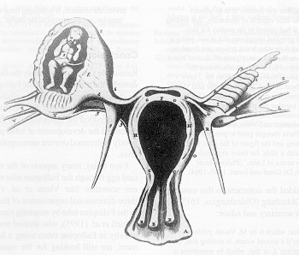Heavy smoking and a history of sexually transmitted disease (SID) are the main factors of ectopic pregnancy, according to results of a population-based study conducted in central France. (1) Among women in one region, those who had smoked 20 or more cigarettes a day had four times the odds of having an ectopic pregnancy of those who had never smoked; those who had had an STD and confirmed pelvic inflammatory disease had more than three times the odds of those with no STD history. Each of these factors accounted for nearly one-third of ectopic pregnancies: Whereas previous research has yielded mixed results regarding the role of age as a risk factor, this study found an independent association between increasing age and an elevated risk of ectopic pregnancy.
An ectopic pregnancy register established in the Auvergne region in 1992 enabled researchers to gather information on all women aged 15-44 who had been treated for ectopic pregnancy at a maternity hospital or surgical unit between 1993 and 2000. For each woman, the investigators selected two controls from among those who had given birth at the same facility where the woman had been treated, at roughly the same time. They restricted their analyses to women who had not been using contraceptives. In all, 803 women with ectopic pregnancies and 1,683 controls were included in the analyses.
Using data from the register, the researchers conducted univariate analyses of the risk of ectopic pregnancy associated with women's background characteristics; surgical, gynecologic and obstetric history;, STD risk factors and history; and contraceptive use and fertility-related characteristics. They performed logistic regression analyses to assess independent associations of factors with significant results at the univariate level.
The multivariate results showed a strong relationship between smoking and ectopic pregnancy risk: Compared with women who had never smoked, those who had smoked in the past had 50% higher odds of ectopic pregnancy (odds ratio, 1.5); the differential was larger for current smokers and climbed as the number of cigarettes smoked daily increased. The odds for women who smoked most heavily--20 or more cigarettes a day--were 3.9 times the odds of never-smokers.
STD history was another important factor in ectopic pregnancy risk. Women who had had an STD with a confirmed diagnosis of pelvic inflammatory disease had more than tripled odds of ectopic pregnancy (odds ratio, 3.4), compared with those who had never had an STD. Tubal surgery, which may occur because of STD-related infection, also was associated with substantially elevated odds of ectopic pregnancy (4.0).
As women's age increased, the risk of ectopic pregnancy grew. The sharpest rise occurred after age 40: Whereas women in their late 30s had 40% higher odds of ectopic pregnancy than those in their late 20s, women aged 40 or older had nearly three times the odds of those aged 25-29 (odds ratio, 2.9).
In some instances, previous pregnancy terminations were associated with increased odds of ectopic pregnancy. Women who had had one or two spontaneous abortions had no greater risk of ectopic pregnancy than those who had had none; the risk was elevated, however, for those who had had three or more (odds ratio, 3.0). And whereas women who had had only surgical abortions were at no greater risk than those who had never had an abortion, women who had had a medical abortion had elevated odds (2.8).
Previous IUD use was associated with a marginally significant 30% increase in the odds of ectopic pregnancy, and previous pill use with a 30% reduction in risk. Women who had experienced any period of infertility were at increased risk; odds ratios ranged from 2.1 for those who had been infertile for less than one year to 2.7 for those who had had this experience for more than two years. The researchers note that the relationship between infertility and ectopic pregnancy is particularly complex because each condition may be viewed as a consequence of the other, and they emphasize the importance of identifying common risk factors for the two.
Overall, the factors studied accounted for 76% of all ectopic pregnancies. Past or current smoking and STD history, taken together with a history of tubal surgery, contributed 35% and 33%, respectively. Each of the others factors contributed 18% or fewer. (Multiple factors may contribute to any occurrence of ectopic pregnancy, and individual proportions therefore add to more than the overall figure.)
"In terms of public health," the investigators comment, "increasing awareness of the role of smoking may be useful in the formulation of ectopic pregnancy prevention policies." They add that the effects of rising STD incidence should also be evaluated.
REFERENCE
(1.) Bouyer J et al., Risk factors for ectopic pregnancy: a comprehensive analysis based on a large case-control, population-based study in France, American Journal of Epidemiology, 2003, 157(3):185-194.
COPYRIGHT 2003 Alan Guttmacher Institute
COPYRIGHT 2003 Gale Group



